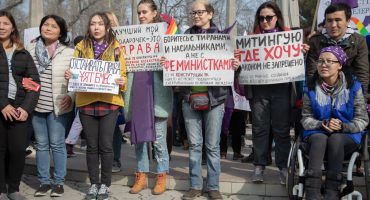If words “authoress,” “professoress” and “female diplomat” are still horrible to the ear, the CABAR.asia media school with the female editor-in-chief of Kloop.kg, Anna Kapushenko, have prepared some cards for you about what feminine gender marking is, why journalists use them, and why they are an absolute standard in the modern Russian language.
The term “feminitive” (feminine gender marking) have several meanings.
The first one denotes the profession, social background. These are neologisms of feminine gender, formed and paired with the relevant noun in masculine gender. This meaning is not correct because feminine gender markings do not always have a pair.
The second meaning is the women’s name as an alternative to the men’s. That’s closer to truth.
And the third one is that a feminitive is a linguistic tool of advocacy on gender equality. This definition is not linguistic, yet it is concise and true in terms of sociology.
Sometimes, they are borrowed words from other languages: Polish, Czech and Bulgarian. These languages contain more feminine gender markings than the Russian language. The –k suffix is easy for Russian speakers: professor becomes professoress (“professorka” in Russian). For example, these are the pairs in the Bulgarian language: автор – авторка (author-authoress), лекар – лекарка (doctor-female doctor), мениджър – мениджърка (manager-manageress), in Czech language: autor – autorka, doktor — doktorka.
Suffixes –alk, -elk (as in sidelka – nurse), -ess (as in authoress, pilotess) are used less often. Some words are traditionally formed by changing the ending: bolnoy-bolnaya (patient-patientess). It is easier to say “uchenaya” (scientistess) than “zhenshina-uchenyi” (literally, female scientist).
Thanks to “princess” and “countess” in the post-war period in the USSR, it was fashionable among the intelligentsia to use feminine gender markings in denoting scientific occupations in feminine gender: “ethnografinya” (female anthropologist), “geologinya” (female geologist), “biologinya” (female biologist). Now this suffix is rarely seen.
No, not all. In some Romance languages, it is enough to add a relevant article and the word becomes either masculine or feminine.
By the way, three years ago France officially recognised feminine gender markings to denote occupations. Now, even the French Academy admits the use of the word professeure (professoress) instead of the masculine version professeur (professor).
In the Kyrgyz language, just like on other Turkic languages, there is no gender. Thus, the issue of feminine gender marking in Central Asian states with one of the Turkic languages as the main language of communication is relevant only for Russian-language media.
First, it increases the visibility of women in occupations.
For example, it was very difficult for women to get a high ranking post as they were traditionally assigned to be as cleaners, housekeepers. And these feminine gender markings did not and are not embarrassing anyone. Now, a woman can be a lawyeress, editoress, female deputy, or presidentess. Unfortunately, these words irritate many people.
Moreover, feminine gender markings sometimes help clarify the text. It happens when, for example, a heroine of your material has a surname that has no gender-specific ending and holds a post that is usually taken as a masculine one.
According to the experience of kloop.kg, not all journalists want to use feminine gender markings in their materials, which is normal. There is a debate about this question in the editorial office; it means that journalists think about how to present their materials all the time.
Besides, in some cases, heroines of materials do not want to have their story told with the use of feminine gender markings. For example, not all women in the parliament are ready to be called “female deputies.” This is also quite normal as views differ.
The argument of the Russian language purity is one of the most widespread. However, it sounds somewhat naïve if we take into account that all languages, but “dead ones”, like Latin, are constantly developing and changing.
Many modern Anglicisms, for example, today have become standard, and everyone is taking it fine. Just like the fact that the word “coffee” is now a neuter noun.
Why can’t we use feminine gender markings when calling women of a certain profession then?
Unfortunately, it makes no sense. Journalists of kloop.kg first tried to communicate with everyone who was perplexed about the use of feminine gender markings in articles. But the point is that not all want to change their views. Sometimes, comments about feminine gender markings are posted for hype only.
We can explain only to those who want to have a dialogue and want to learn our position. It’s a waste of resources to explain trolls the importance of feminine gender markings in the advocacy on gender equality.
Reaction of internet trolls on feminine gender markings in journalistic articles can divert the focus. People would pay more attention to the use of strange sounding words in a text, rather than to important things written about.
Therefore, it is useful to avoid feminine gender markings in some articles, or else no one would get to the point.
It’s probably because they, conditionally, “hit the nerve” of the audience. In other words, hatred of feminine gender markings means the following: the society does not want to admit that women’s rights are violated in Kyrgyzstan and we are far from the gender equality.
The same hatred in many readers can be caused by an article about homicide of women by men and about the little number of women in high ranking posts in politics and government. Now the society is at the stage of anger and denial of existing problems. To start solving them, the society must admit the fact that women are not equal to men in many aspects, and in many situations they are even vulnerable. Only after we recognise the problem, we can start solving it by making changes in the existing reality, which will lead to the reduction of gender inequality.
There is no such need for the Turkic languages.
If we speak about the statutory use of feminine gender markings in Russian-language media, it can help. At least, to the younger generation. They will grow up in the world where words “doctoress,” “wrestleress” or “presidentess” are standard words and will not worry about some media outlet “making the language ugly” by using such words.
Moreover, some professions still have few women and if these professions are denoted by feminine gender markings, and female specialists in these spheres are demonstrated, there’s a chance that little girls will choose their occupation despite the stereotypes and public pressure. As we all know, there are “non-female” professions and girls encounter some resistance even from parents when they want to study programming, for example.
By the way, this approach proved to be effective for Ukraine, where feminine gender markings were officially approved after 2019 and fixed at the national level. According to Ukraine-based journalists, even the most persistent opponents to the use of new “feminine” words in the media, like “Ukrainskaya Pravda” or “Novoye Vremya”, gave up. The only media outlets that do not use feminine gender markings are Russian media outlets that continue to publish news in Russian.
This publication was produced as part of the mentorship programme under the Development of New Media and Digital Journalism in Central Asia project delivered by the Institute for War and Peace Reporting (IWPR) with support from the UK Government. It does not necessarily reflect the official views of IWPR or the UK Government
If you have found a spelling error, please, notify us by selecting that text and pressing Ctrl+Enter.





